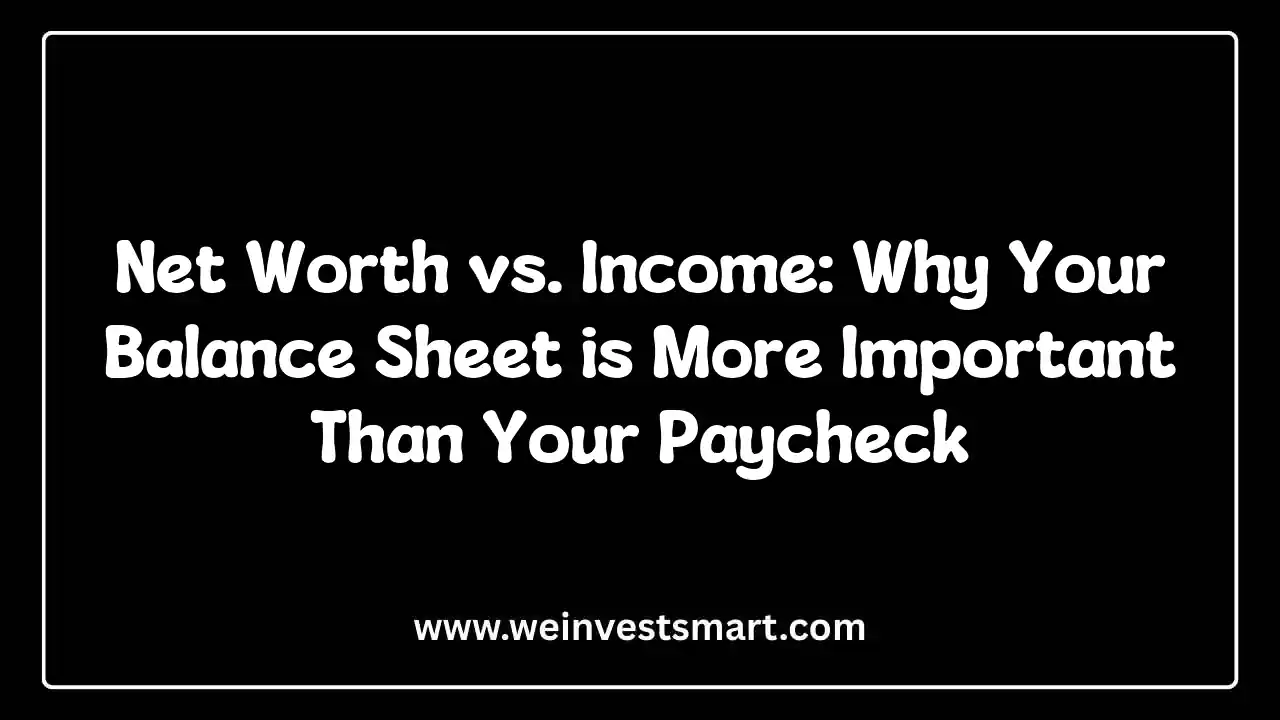· WeInvestSmart Team · wealth-building · 13 min read
The 3 Levers of Wealth Building: Earning, Saving, and Investing
A foundational post that explains that wealth is a simple formula. To accelerate wealth, you must pull on one or more of these levers: increasing your income, increasing your savings rate, or increasing your investment returns.
Most people believe that building wealth is a complex, esoteric art, a secret code reserved for Wall Street wizards and Silicon Valley wunderkinds. They spend their lives searching for a “magic bullet”—that one hot stock, that one clever trick—that will unlock the gates to financial prosperity. They’re convinced it’s about genius or luck. But here’s the uncomfortable truth: they’re profoundly wrong. The formula for building wealth isn’t a secret. It’s a machine.
Going straight to the point, the mechanics of wealth are brutally, almost disappointingly, simple. The problem isn’t that the information is hidden; it’s that the real process sounds too much like hard work and discipline, so people ignore it in favor of more exciting fantasies. But once you understand the machine, you can stop searching for secrets and start operating it.
This machine has three, and only three, fundamental levers: Earning, Saving, and Investing. That’s it. Every single wealth story, from Warren Buffett to the neighbor who retired at 45, is a story about manipulating these three levers. And this is just a very long way of saying that to accelerate your journey to financial independence, you don’t need a secret password. You just need to know which lever to pull, how hard to pull it, and when.
The Wealth Equation: A Machine, Not a Mystery
Before we start pulling levers, we need to understand the engine they control. At its core, the process of wealth accumulation can be distilled into a simple, observable formula. Think of it as the physics of finance. Your net worth tomorrow is a function of what you do today, governed by this equation:
Wealth Growth = (Income - Expenses) + (Invested Capital x Rate of Return)
The first part, (Income - Expenses), is your Savings. It’s the raw material, the fuel you add to the fire each year. The second part, (Invested Capital x Rate of Return), is your Investment Growth. It’s the fire itself, the compounding engine that makes your capital grow on its own. Every dollar you have is either working for you in the second part of the equation or waiting to be deployed from the first.
Here’s where things get interesting. Most people treat these components as separate ideas. They think about their job, their budget, and their 401(k) in isolation. This is a critical error. You must see them as interconnected parts of a single machine. Earning more money (pulling the Income lever) is useless if your expenses rise just as fast. Saving a huge portion of your income (pulling the Savings lever) is powerful, but its potential is capped until you put that money to work. And investing (pulling the Investment lever) can’t happen without capital from the first two. You get the gist: the levers are a system, and mastering the system is the true secret.
You may also be interested in: The Millionaire Next Door: 7 Surprising Habits of Everyday Millionaires
Lever 1: Earning — The Engine of Your Wealth Machine
The first lever, Earning, is the most intuitive. It’s the raw horsepower of your wealth-building engine. Without income, there is nothing to save and nothing to invest. This sounds obvious, but its strategic importance is often misunderstood. In the early stages of your financial life, your ability to earn is, without question, the most powerful lever you have. The mathematical impact of a 10% raise on a $50,000 salary is far greater than a 10% return on a $5,000 investment portfolio.
The funny thing is that for most people, pulling the Earning lever harder does almost nothing for their net worth. This is due to a psychological trap called lifestyle inflation. They get a raise, and their first thought isn’t “How much more can I save and invest?” but “What new monthly payment can I afford?” They upgrade the car, the apartment, the vacation. They mistake a higher income for wealth, when in reality, wealth is what you keep, not what you make. The goal isn’t just to increase the flow of money to you, but to increase the flow of money through you into assets you own.
How to Pull the Earning Lever Effectively:
- Optimize Your Primary Career: Your main job is your single biggest wealth-building tool. Don’t treat it passively. Actively pursue promotions, acquire high-demand skills that justify a higher salary, and don’t be afraid to strategically change jobs to secure significant pay bumps. Think of your career as an asset and work to increase its return.
- Build Secondary Income Streams: Creating additional income sources is about more than just extra cash; it’s about building financial resilience. This could be freelancing a skill you have, consulting for small businesses, or starting a small-scale side business. Each new stream diversifies your income, reducing your reliance on a single employer.
- Transition from Active to Passive Income: This is the advanced stage of the Earning lever. Active income is when you trade your time for money. Passive income is when your assets earn money for you. This sounds like a trade-off, but it’s actually the endgame. Using the earnings from your active labor to buy assets (like dividend stocks, rental properties, or intellectual property) that generate passive income is the crucial transition from working for money to having money work for you.
You may also be interested in: The Ladder of Personal Finance: A Visual Guide to Building Wealth
Lever 2: Saving — The Great Multiplier
If Earning is the engine, Saving is the transmission that transfers that power to the wheels. It dictates what percentage of your engine’s output actually results in forward motion. Many people dismiss saving as a painful exercise in deprivation, a choice to live a smaller life. But this is a fundamental misunderstanding of its power.
Going straight to the point, your Savings Rate—the percentage of your income you save and invest—is the single most important and controllable factor in your wealth journey, especially in the first decade. It has a dual impact: every dollar you save not only increases the amount of capital you have to invest, but it also reduces the amount of capital you’ll eventually need to live on. Someone who lives on 50% of their income is not only saving half their salary, they are also training themselves to need a smaller nest egg for retirement.
The math is undeniable. Someone with a 10% savings rate will take roughly 51 years to reach financial independence. But increase that to 25%, and the timeline drops to 32 years. At a 50% savings rate, it’s just 17 years. This isn’t a small difference; it’s the difference between retiring in your sixties and retiring in your forties. Your savings rate is a direct control on your retirement date.
How to Pull the Saving Lever Effectively:
- Focus on the “Big Three”: Stop agonizing over the daily latte. The vast majority of household spending is concentrated in three areas: housing, transportation, and food. Making one big, conscious decision—like living in a smaller house, closer to work, or driving a used car for a few extra years—has a thousand times more impact than a lifetime of clipping coupons.
- Automate Your Financial Discipline: Human willpower is a finite and unreliable resource. Don’t depend on it. The most effective way to save is to remove yourself from the equation. Set up automatic transfers from your checking account to your investment and savings accounts the day you get paid. This “pay yourself first” strategy ensures your future is funded before your present self has a chance to spend the money.
- Practice Intentional Spending, Not Deprivation Budgeting: A line-by-line budget that tracks every penny is fragile and often leads to burnout. A more robust approach is to be ruthlessly intentional. Identify what truly brings you value and spend extravagantly on it. Then, cut mercilessly from everything else. It’s about aligning your spending with your values, not just minimizing it.
You may also be interested in: Your Savings Rate: The Most Important Number in Personal Finance
Lever 3: Investing — The Force of Compounding
Investing is the final lever, and it’s where the magic happens. If Earning provides the fuel and Saving provides the capital, Investing is the force multiplier that ignites that capital with the power of compound growth. It’s the process of turning your money into a self-replicating army that works for you 24/7, even while you sleep. Without this lever, you are merely accumulating money. With it, you are building wealth.
Most people are intimidated by investing, viewing it as a form of high-stakes gambling best left to experts. But here’s the secret: successful long-term investing isn’t about picking winning stocks or timing the market. It’s about owning a piece of the broad economic engine of the world and then getting out of the way for a very long time.
The power of this lever is driven by two variables: your rate of return and, more importantly, time. Time is the secret ingredient in compounding. The earlier you start, the more time your money has to grow, and the growth becomes exponential. A dollar invested at age 25 is exponentially more powerful than a dollar invested at age 45, because it has two extra decades to compound. This is why starting early, even with small amounts, is more critical than starting later with large amounts.
How to Pull the Investing Lever Effectively:
- Embrace Low-Cost Index Funds: For the vast majority of people, the most effective investment strategy is to buy and hold low-cost, broad-market index funds or ETFs. An index fund is a simple vehicle that owns small pieces of every company in a major market index, like the S&P 500. It provides instant diversification, is incredibly cheap, and has historically delivered strong returns over the long run. This isn’t settling; it’s choosing a proven, powerful, and simple strategy.
- Stay Consistent with Dollar-Cost Averaging: Don’t try to time the market. It’s a fool’s errand. Instead, commit to investing a fixed amount of money at regular intervals (e.g., every month), regardless of whether the market is up or down. This strategy, known as dollar-cost averaging, removes emotion from the equation and ensures you buy more shares when prices are low and fewer when they are high.
- Understand Your Risk Tolerance and Time Horizon: Your investment strategy should align with your personal goals and timeline. If you need the money in five years, you should take far less risk than if you are investing for retirement in 30 years. The key is to create a plan you can stick with through market volatility without panicking.
You may also be interested in: How to Build Multiple Income Streams: A Guide for Beginners
The Symphony of Levers: A Lifetime of Strategy
The true art of wealth building is not just pulling these levers, but knowing how to orchestrate them throughout your life. Their relative importance changes as you progress on your financial journey.
- In Your 20s and Early 30s: Your primary focus should be on Earning and Saving. Your income is your most powerful tool, and building a high savings rate is paramount. At this stage, your human capital (your ability to earn) is your biggest asset. The returns on your small but growing portfolio are less impactful than your ability to add new capital to it.
- In Your 30s and 40s: Your Savings Rate is still the star of the show, but the Investing lever is becoming a powerful co-star. The snowball of your investments is getting larger. There will come a point—a truly magical crossover point—where the annual growth of your investments is greater than the amount you are saving. This is when your money starts doing the heavy lifting.
- In Your 50s and Beyond: The Investing lever becomes the dominant force. The power of decades of compounding is now fully unleashed. Your portfolio is a massive engine of growth, and its returns will likely dwarf what you can contribute from your salary. Your focus shifts from accumulation to capital preservation and strategic withdrawal.
You get the gist: Earning fills the bucket. Saving plugs the leaks and determines how much water you keep. Investing makes the water in the bucket grow on its own. You need all three operating in harmony.
You may also be interested in: Net Worth vs. Income: Why Your Balance Sheet is More Important Than Your Paycheck
The Bottom Line: Stop Searching, Start Pulling
For too long, the pursuit of wealth has been shrouded in a false narrative of complexity and genius. It’s been framed as a game you can only win if you know the secret plays. But it isn’t a game. It’s a machine. And the controls are right in front of you.
Stop looking for the hot stock tip. Stop waiting for the perfect moment. Stop believing you need to be a financial guru to succeed. The path is clear. Increase what you earn. Increase the gap between what you earn and what you spend. And consistently invest that difference in assets that grow over time. That’s it. That is the entire strategy.
And this is just a very long way of saying that your financial future will be determined not by the secrets you uncover, but by the levers you choose to pull, starting today. The power is, and always has been, in your hands.
This article is for educational purposes only and should not be considered personalized financial advice. Consider consulting with a financial advisor for guidance specific to your situation.
The 3 Levers of Wealth Building FAQ
What is the wealth building formula?
The wealth building formula is a simple equation: increase your income, increase your savings rate from that income, and increase the rate of return on your investments. Mastering these three levers—Earning, Saving, and Investing—is the key to building wealth.
Which lever is most important for building wealth?
The importance of each lever changes over your lifetime. Early in your career, Earning and Saving are most important because they build your initial capital. Later in life, Investing becomes the most powerful lever as compound growth accelerates your wealth far beyond what you can save alone.
How can I increase my income?
You can increase your income by negotiating a higher salary in your primary job, developing high-value skills, strategically changing jobs, or creating additional income streams through side hustles like freelancing, consulting, or creating digital products.
What is a good savings rate?
While a common recommendation is 15-20%, those serious about building wealth often aim for a savings rate of 25-50% or even higher. A higher savings rate dramatically shortens the time it takes to reach financial independence.
What is the easiest way for a beginner to start investing?
For most beginners, the easiest and most effective way to start investing is by buying low-cost, broad-market index funds or ETFs. These funds provide instant diversification and track the performance of a major market index like the S&P 500, making them a simple yet powerful tool for long-term growth.



